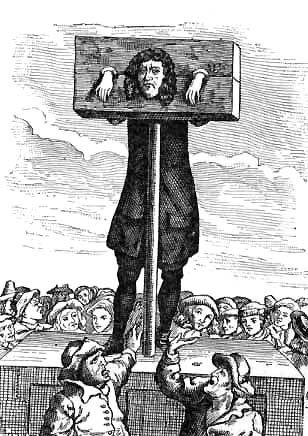
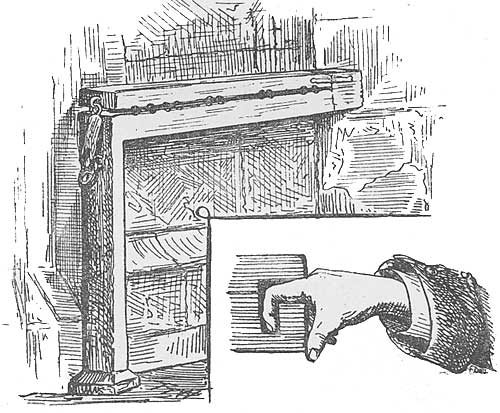
The pillory was a frame of adjustable boards erected on a post and having holes through which the head and hands of an offender were thrust. The image above left shows a pillory where the offender had to stand the whole time. Some frames consisted of perforated iron circles to hold the head and hands. More complicated pillories could secure several people in a row. There were instances of criminals being thrust into a pillory and then being pelted with stones from the watching crowd. I believe that was an earlier use of the pillory which had gone into decline by the 1700s. The pillory was a common instrument of punishment by Scottish churches. The pillory was abolished in England in 1816 except for crimes of perjury and subornation. It was finally abolished in 1837. Finger pillories (above right) were at one time commonly used as instruments of domestic punishment. They consisted of two stout pieces of wood with the top being hinged to the bottom. When the pieces were closed, they provided a number of holes sufficiently deep to lock fingers to the second joint in an uncomfortable position.
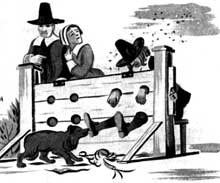
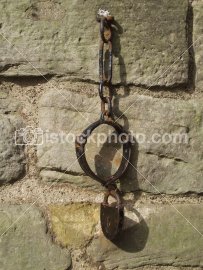
Being put into the "stocks" (above left) was similar to being put into a pillory, but the stocks held the feet and hands. Stocks were reserved for men. The pillory was more uncomfortable. The jougs (above right) was another instrument of punishment. It was an iron collar, fastened by a short chain to a wall, often of the parish church. The collar was placed around the offender's neck and fastened in place. It was essentially a pillory. The humiliating spectacle of such punishments was considered important as a deterrent of repeat offenses and as a cautionary lesson to others.
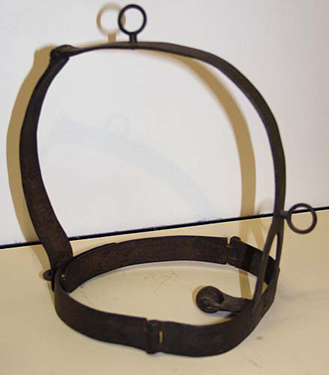
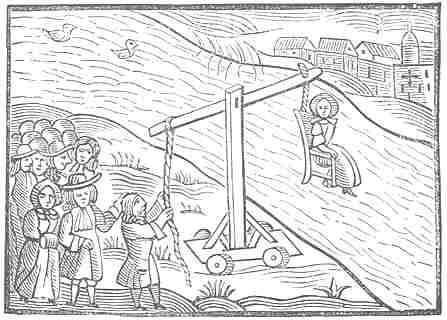
Public disgrace was a central component of many penalties imposed on disobedient or uncooperative females. One transgression in particular was punished with ridicule and debasement: the crime of nagging or scolding. The branks, or bride's scold (above left) was imposed on women who gossiped or spoke too freely but might also be used for women convicted of petty offences, breaches of the peace, street brawling and abusive language. It was a heavy, large iron cage placed on the head of the offender. There was a metal strip on the brank that fit into the mouth over the tongue and was sharpened to a point or covered with spikes so that any movement of the tongue was certain to cause severe injuries to the mouth. The woman was then led through the streets of town by a chain, then usually tied to a whipping posts or pillory to stand in view of the cruel and verbally and physically abusive public. The branks was used as a severe form of punishment that could be applied to women while the whipping post was generally reserved for men.
Although the branks might also be used on men, the ducking stool (above right) was almost exclusively used for women, generally for over-talkative women. It might also be used for slanderers, chyderers, brawlers, railers, and women of light carriage (women of questionable morals). The ducking stool was a wooden chair attached to a large lever system which allowed the chair to be raised or lowered without tipping the chair. The chair was then lowered into the water and held the woman under water for a length of time. This was repeated a specified number of times or, in some cases, until the woman repented. Some of the ducking stools were mobile and could be taken to the water's edge as needed; others were fixed into place and served as a grim reminder to the townsfolk of what scolding could lead to. A cucking stool was a version of the ducking stool. It was a strong chair in which an offender (male or female) was fastened, thus to be hooted at or pelted at. It was used for flyting which I had thought would be flirting, but was quarrelling, scolding or employing abusive language. There was no ducking in the water with this form of punishment. The length of sentence might be measured in days.
These forms of punishment were reserved for misdemeanors, church punishment, and such offenses that did not meet the requirement of a capital crime. Examples were drunkenness, cheating a customer, for example short measuring, tampering with scales, and petty theft. One of the most feared punishments in Scotland was having to appear in church every Sunday for a specified number of weeks, to be harangued for half an hour in front of the congregation by the minister. In some churches, offenders were fastened to the wall in iron collars or jougs. This was the common penalty for adulterers and fornicators of both sexes and was greatly feared. So much so, that it caused a sharp rise in the infanticide rate. Some women who had illegitimately become pregnant preferred to risk the capital penalty for infanticide rather than admit the facts and suffer such extreme humiliation.
Sources
Various web sites, including
Bloody Painful http://www.springfield.k12.il.us/schools/Springfield/eliz/Bloodypainful.html
Brainy Dictionary http://www.brainydictionary.com/words/pi/pillory203012.html
Crime and Punishment http://www.tomecek.com/jay/CrimeAndPunishment.html
Love to Know Encyclopedia http://www.1911encyclopedia.org/
Theory of Civilization http://www.ourcivilisation.com/smartboard/shop/taylorgr/sxnhst/chap8.htm